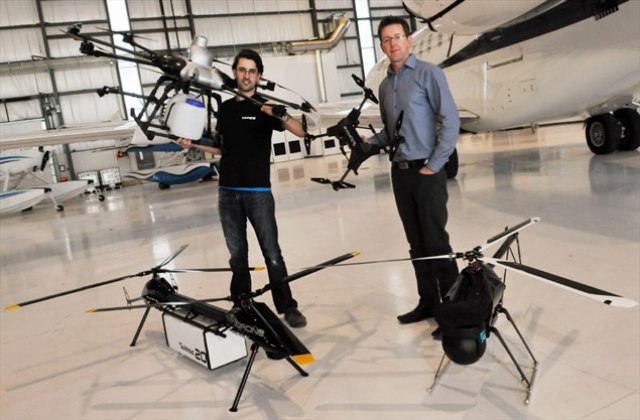
Geoff Gurr, left, and Scott Gray of Avidrone Aerospace show off some of their drones at the company’s new home in the Chartright Air Group hanger in Breslau. – Brent Davis,Record staff
In recent years, Avidrone Aerospace had been flying under the radar. The Breslau-based industrial drone manufacturer was focused on research and development, keeping much of its work under wraps as the company created its own autopilot electronics and flight control software.
“We were working quite stealthily,” says founder and chief executive officer Scott Gray.
But a seed investment from Japanese firm Prodrone this fall and a subsequent move into the large Chartright Air Group hanger at the Region of Waterloo International Airport have prompted Avidrone to fly out of the shadows.
“Moving here is really the unveiling of Avidrone Aerospace,” Gray says of the firm’s new address. “It’s visibility that we really exist.”
Previously, employees were using a different facility at the airport, or working remotely. The new space brings everything under one roof.
Gray founded Avidrone Aerospace about a decade ago as a business that managed his interests in the radio-controlled aviation world. A national champion many times over, Gray competed on the international circuit and conducted demonstrations on behalf of sponsors. He’s also a licensed commercial pilot as well.
That background — combining the knowledge of manned flight and the experience in the radio-controlled world — put Gray in a unique position to pursue the emerging drone, or unmanned aerial vehicle (UAV), industry.
With a team that’s eight strong and growing, Avidrone designs and manufactures automated commercial drones suitable for a host of purposes ranging from delivering packages and carrying cameras to agricultural and military applications.
“We can custom-tailor it really to what the end user needs,” Gray says.
The drones also feature the company’s proprietary autopilot flight control technology, which can also be incorporated into other systems.
“It’s very organic flight logic that we developed,” says chief fabricator and UAV specialist Geoff Gurr. “A pilot’s manual skill has sort of been turned into software code.”
Gray says the company has technology within its flight control that enables the drone to be operated beyond the line of sight. “That’s really the future of what we’re able to do,” he says.
Avidrone’s temporary digs at the Chartright hanger — its custom office and shop space there should be complete in the spring — are full of drones of all shapes and sizes.
“We call it our Skunk Works,” Gray says, a nod to the name given to aerospace giant Lockheed Martin’s Advanced Development Programs.
There are single-rotor vehicles that look like miniature helicopters and ones with six or eight rotors. There are small quad copters weighing just a couple of pounds, and a long, narrow tandem-rotor drone that can take to the skies with a gross weight of up to almost 50 kilograms.
Gurr and Gray say their drones offer performance on both the endurance and payload fronts — capabilities that define what a drone can be used for.
“We lift 30 pound packages, we’ve lifted a bicycle,” Gray says. “We’ve developed a drone that flies for an hour and 20 minutes on electric power. That’s a significant achievement in efficiency.” They’ve also flown a round trip that covered more than 100 kilometres.
Those attributes make the drones desirable for everything from commercial deliveries to military resupply or humanitarian aid missions. Avidrone is working in conjunction with a U.S. company on a logistics drone for military applications that can lift about 200 kilograms.
The investment and partnership agreement with Japan’s Prodrone allows each company to benefit from the other’s technology while expanding sales channels and distribution. “I think it’s a huge advantage in terms of global presence,” says Gray.
Avidrone Aerospace also partners with the Waterloo-Wellington Flight Centre to conduct the practical flight training portion of its UAV pilot training course.
Gray admits that technological advancements are outpacing the regulatory world in which drones are allowed to fly. “It’s a bit of a pinch point. You just can’t start flying these drones all over,” he says. “We’d like to be sooner to market with some of our capabilities.”
Beyond-line-of-sight flights, for example, are only allowed in certain cases, he says.
But he’s sure those restrictions will be relaxed as the sector grows and more potential users realize the cost savings, speed and efficiencies that drones can provide.
“It’s an entirely new way of doing something,” Gray says. “Some industries don’t realize they could use a drone or need a drone.”
Source: The Record
